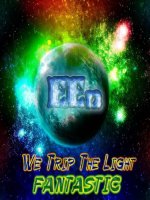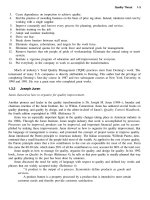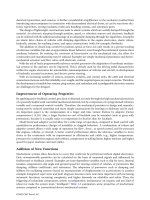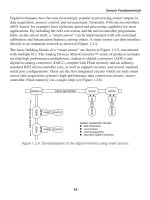THE MECHATRONICS HANDBOOK P2
Bạn đang xem bản rút gọn của tài liệu. Xem và tải ngay bản đầy đủ của tài liệu tại đây (1.7 MB, 20 trang )
electrical typewriters, and cameras. A further considerable
simplification in the mechanics
resulted from
introducing microcomputers in connection with decentralized electrical drives, as can be seen from elec-
tronic typewriters, sewing machines, multi-axis handling systems, and automatic gears.
The design of lightweight constructions leads to elastic systems which are weakly damped through the
material. An
electronic damping
through position, speed, or vibration sensors and electronic feedback
can be realized with the additional advantage of an adjustable damping through the algorithms. Examples
are elastic drive chains of vehicles with damping algorithms in the engine electronics, elastic robots,
hydraulic systems, far reaching cranes, and space constructions (with, for example, flywheels).
The addition of closed loop control for position, speed, or force not only results in a precise tracking
of reference variables, but also an approximate linear behavior, even though the mechanical systems show
nonlinear behavior. By
omitting the constraint of linearization
on the mechanical side, the effort for
construction and manufacturing may be reduced. Examples are simple mechanical pneumatic and electro-
mechanical actuators and flow valves with electronic control.
With the aid of freely
programmable reference variable generation
the adaptation of nonlinear mechan-
ical systems to the operator can be improved. This is already used for the driving pedal characteristics
within the engine electronics for automobiles, telemanipulation of vehicles and aircraft, in development
of hydraulic actuated excavators, and electric power steering.
With an increasing number of sensors, actuators, switches, and control units, the cable and electrical
connections increase such that reliability, cost, weight, and the required space are major concerns. Therefore,
the development of suitable bus systems, plug systems, and redundant and reconfigurable electronic systems
are challenges for the designer.
Improvement of Operating Properties
By applying active feedback control, precision is obtained not only through the high mechanical precision
of a passively feedforward controlled mechanical element, but by comparison of a programmed reference
variable and a measured control variable. Therefore, the mechanical precision in design and manufac-
turing may be reduced somewhat and more simple constructions for bearings or slideways can be used.
An important aspect is the compensation of a larger and time variant friction by
adaptive friction
compensation
[13,20]. Also, a larger friction on cost of backlash may be intended (such as gears with
pretension), because it is usually easier to compensate for friction than for backlash.
Model-based
and
adaptive control
allow for a wide range of operation, compared to fixed control with
unsatisfactory performance (danger of instability or sluggish behavior). A combination of robust and
adaptive control allows a wide range of operation for flow-, force-, or speed-control, and for processes
like engines, vehicles, or aircraft. A better control performance allows the reference variables to move
closer to the constraints with an improvement in efficiencies and yields (e.g., higher temperatures,
pressures for combustion engines and turbines, compressors at stalling limits, higher tensions and higher
speed for paper machines and steel mills).
Addition of New Functions
Mechatronic systems allow functions to occur that could not be performed without digital electronics.
First,
nonmeasurable quantities
can be calculated on the basis of measured signals and influenced by
feedforward or feedback control. Examples are time-dependent variables such as slip for tyres, internal
tensities, temperatures, slip angle and ground speed for steering control of vehicles, or parameters like
damping, stiffness coefficients, and resistances. The
adaptation of parameters
such as damping and
stiffness for oscillating systems (based on measurements of displacements or accelerations) is another
example. Integrated
supervision and fault
diagnosis
becomes more and more important with increasing
automatic functions, increasing complexity, and higher demands on reliability and safety. Then, the
triggering of redundant components, system reconfiguration, maintenance-on-request, and any kind of
teleservice
make the system more “intelligent.” Table 2.2 summarizes some properties of mechatronic
systems compared to conventional electro-mechanical systems.
©2002 CRC Press LLC
2.3 Ways of Integration
Figure 2.3 shows a general scheme of a classical mechanical-electronic system. Such systems resulted from
adding available sensors, actuators, and analog or digital controllers to mechanical components. The limits
of this approach were given by the lack of suitable sensors and actuators, the unsatisfactory life time
under rough operating conditions (acceleration, temperature, contamination), the large space require-
ments, the required cables, and relatively slow data processing. With increasing improvements in minia-
turization, robustness, and computing power of microelectronic components, one can now put more
emphasis on electronics in the design of a mechatronic system. More autonomous systems can be envisioned,
such as capsuled units with touchless signal transfer or bus connections, and robust microelectronics.
The integration within a mechatronic system can be performed through the integration of components
and through the integration of information processing.
Integration of Components (Hardware)
The integration of components (hardware integration) results from designing the mechatronic system
as an overall system and imbedding the sensors, actuators, and microcomputers into the mechanical
process, as seen in Fig. 2.4. This spatial integration may be limited to the process and sensor, or to the
process and actuator. Microcomputers can be integrated with the actuator, the process or sensor, or can
be arranged at several places.
Integrated sensors and microcomputers lead to
smart sensors
, and integrated actuators and microcom-
puters lead to
smart actuators
. For larger systems, bus connections will replace cables. Hence, there are
several possibilities to build up an integrated overall system by proper integration of the hardware.
Integration of Information Processing (Software)
The integration of information processing (software integration) is mostly based on advanced control
functions. Besides a basic feedforward and feedback control, an additional influence may take place
through the process knowledge and corresponding online information processing, as seen in Fig. 2.4.
This means a processing of available signals at higher levels, including the solution of tasks like supervision
TABLE 2.2
Properties of Conventional and Mechatronic Design Systems
Conventional Design Mechatronic Design
Added components Integration of components (hardware)
1 Bulky Compact
2 Complex mechanisms Simple mechanisms
3 Cable problems Bus or wireless communication
4 Connected components Autonomous units
Simple control Integration by information processing (software)
5 Stiff construction Elastic construction with damping by electronic feedback
6 Feedforward control, linear (analog) control Programmable feedback (nonlinear) digital control
7 Precision through narrow tolerances Precision through measurement and feedback control
8 Nonmeasurable quantities change arbitrarily Control of nonmeasurable estimated quantities
9 Simple monitoring Supervision with fault diagnosis
10 Fixed abilities Learning abilities
FIGURE 2.3
General scheme of a (classical) mechanical-electronic system.
©2002 CRC Press LLC
with fault diagnosis, optimization, and general process management. The respective problem solutions
result in real-time algorithms which must be adapted to the mechanical process properties, expressed by
mathematical models in the form of static characteristics, or differential equations. Therefore, a
knowledge
base
is required, comprising methods for design and information gaining, process models, and perfor-
mance criteria. In this way, the mechanical parts are governed in various ways through higher level
information processing with intelligent properties, possibly including learning, thus forming an integra-
tion by process-adapted software.
2.4 Information Processing Systems (Basic Architecture
and HW/SW Trade-offs)
The governing of mechanical systems is usually performed through actuators for the changing of posi-
tions, speeds, flows, forces, torques, and voltages. The directly measurable output quantities are frequently
positions, speeds, accelerations, forces, and currents.
Multilevel Control Architecture
The information processing of
direct measurable input and output signals
can be organized in several
levels, as compared in Fig. 2.5.
level 1: low level control (feedforward, feedback for damping, stabilization, linearization)
level 2: high level control (advanced feedback control strategies)
level 3: supervision, including fault diagnosis
level 4: optimization, coordination (of processes)
level 5: general process management
Recent approaches to mechatronic systems use signal processing in the lower levels, such as damping,
control of motions, or simple supervision. Digital information processing, however, allows for the
solution of many tasks, like adaptive control, learning control, supervision with fault diagnosis, decisions
FIGURE 2.4
Ways of integration within mechatronic systems.
©2002 CRC Press LLC
for maintenance or even redundancy actions, economic optimization, and coordination. The tasks of the
higher levels are sometimes summarized as “process management.”
Special Signal Processing
The described methods are partially applicable for
nonmeasurable quantities
that are reconstructed from
mathematical process models. In this way, it is possible to control damping ratios, material and heat
stress, and slip, or to supervise quantities like resistances, capacitances, temperatures within components,
or parameters of wear and contamination. This signal processing may require
special filters
to determine
amplitudes or frequencies of vibrations, to determine derivated or integrated quantities, or
state variable
observers
.
Model-based and Adaptive Control Systems
The information processing is, at least in the lower levels, performed by simple algorithms or software-
modules under real-time conditions. These algorithms contain free adjustable parameters, which have
to be adapted to the static and dynamic behavior of the process. In contrast to manual tuning by trial
and error, the use of mathematical models allows precise and fast automatic adaptation.
The mathematical models can be obtained by identification and parameter estimation, which use the
measured and sampled input and output signals. These methods are not restricted to linear models, but
also allow for several classes of nonlinear systems. If the parameter estimation methods are combined
with appropriate control algorithm design methods, adaptive control systems result. They can be used
for permanent precise controller tuning or only for commissioning [20].
FIGURE 2.5
Advanced intelligent automatic system with multi-control levels, knowledge base, inference mecha-
nisms, and interfaces.
©2002 CRC Press LLC
Supervision and Fault Detection
With an increasing number of automatic functions (autonomy), including electronic components, sen-
sors and actuators, increasing complexity, and increasing demands on reliability and safety, an integrated
supervision with fault diagnosis becomes more and more important. This is a significant natural feature
of an intelligent mechatronic system. Figure 2.6 shows a process influenced by faults. These faults indicate
unpermitted deviations from normal states and can be generated either externally or internally. External
faults can be caused by the power supply, contamination, or collision, internal faults by wear, missing
lubrication, or actuator or sensor faults. The classical way for fault detection is the limit value checking
of some few measurable variables. However, incipient and intermittant faults can not usually be detected,
and an in-depth fault diagnosis is not possible by this simple approach.
Model-based fault detection
and
diagnosis methods
were developed in recent years, allowing for early detection of small faults with normally
measured signals, also in closed loops [21]. Based on measured input signals,
U
(
t
), and output signals,
Y
(
t
), and process models, features are generated by parameter estimation, state and output observers,
and parity equations, as seen in Fig. 2.6.
These residuals are then compared with the residuals for normal behavior and with change detection
methods analytical symptoms are obtained. Then, a fault diagnosis is performed via methods of classi-
fication or reasoning. For further details see [22,23].
A considerable advantage is if the same process model can be used for both the (adaptive)
controller
design and the fault detection
. In general, continuous time models are preferred if fault detection is based
on parameter estimation or parity equations. For fault detection with state estimation or parity equations,
discrete-time models can be used.
Advanced supervision and fault diagnosis is a basis for improving reliability and safety, state dependent
maintenance, triggering of redundancies, and reconfiguration.
Intelligent Systems (Basic Tasks)
The information processing within mechatronic systems may range between simple control functions
and intelligent control. Various definitions of intelligent control systems do exist, see [24–30]. An intel-
ligent control system may be organized as an
online expert system
, according to Fig. 2.5, and comprises
• multi-control functions (executive functions),
• a knowledge base,
• inference mechanisms, and
• communication interfaces.
FIGURE 2.6
Scheme for a model-based fault detection.
©2002 CRC Press LLC
The online
control functions
are usually organized in multilevels, as already described. The
knowledge
base
contains quantitative and qualitative knowledge. The quantitative part operates with analytic (math-
ematical) process models, parameter and state estimation methods, analytic design methods (e.g., for
control and fault detection), and quantitative optimization methods. Similar modules hold for the
qualitative knowledge (e.g., in the form of rules for fuzzy and soft computing). Further knowledge is the
past history in the memory and the possibility to predict the behavior. Finally, tasks or schedules may
be included.
The
inference mechanism
draws conclusions either by quantitative reasoning (e.g., Boolean methods)
or by qualitative reasoning (e.g., possibilistic methods) and takes decisions for the executive functions.
Communication between the different modules, an information management database, and the man–
machine interaction has to be organized.
Based on these functions of an online expert system, an intelligent system can be built up, with the
ability “to model, reason and learn the process and its automatic functions within a given frame and to
govern it towards a certain goal.” Hence, intelligent mechatronic systems can be developed, ranging from
“low-degree intelligent” [13], such as intelligent actuators, to “fairly intelligent systems,” such as self-
navigating automatic guided vehicles.
An
intelligent mechatronic system
adapts the controller to the mostly nonlinear behavior (adaptation),
and stores its controller parameters in dependence on the position and load (learning), supervises all relevant
elements, and performs a fault diagnosis (supervision) to request maintenance or, if a failure occurs, to
request a fail safe action (decisions on actions). In the case of multiple components, supervision may help
to switch off the faulty component and to perform a reconfiguration of the controlled process.
2.5 Concurrent Design Procedure for Mechatronic Systems
The design of mechatronic systems requires a systematic development and use of modern design tools.
Design Steps
Table 2.3 shows five important development steps for mechatronic systems, starting from a purely
mechanical system and resulting in a fully integrated mechatronic system. Depending on the kind of
mechanical system, the intensity of the single development steps is different. For precision mechanical
devices, fairly integrated mechatronic systems do exist. The influence of the electronics on
mechanical
elements
may be considerable, as shown by adaptive dampers, anti-lock system brakes, and automatic
gears. However, complete
machines
and
vehicles
show first a mechatronic design of their elements, and
then slowly a redesign of parts of the overall structure as can be observed in the development of machine
tools, robots, and vehicle bodies.
Required CAD
//
//
CAE Tools
The computer aided development of mechatronic systems comprises:
1. constructive specification in the engineering development stage using CAD and CAE tools,
2. model building for obtaining static and dynamic process models,
3. transformation into computer codes for system simulation, and
4. programming and implementation of the final mechatronic software.
Some software tools are described in [31]. A broad range of CAD/CAE tools is available for 2D- and
3D-mechanical design, such as Auto CAD with a direct link to CAM (computer-aided manufacturing),
and PADS, for multilayer, printed-circuit board layout. However, the state of computer-aided modeling
is not as advanced. Object-oriented languages such as DYMOLA and MOBILE for modeling of large
combined systems are described in [31–33]. These packages are based on specified ordinary differential
©2002 CRC Press LLC
equations, algebraic equations, and discontinuities. A recent description of the state of computer-aided
control system design can be found in [34]. For system simulation (and controller design), a variety of
program systems exist, like ACSL, SIMPACK, MATLAB/SIMULINK, and MATRIX-X. These simulation
techniques are valuable tools for design, as they allow the designer to study the interaction of components
and the variations of design parameters before manufacturing. They are, in general, not suitable for real-
time simulation.
Modeling Procedure
Mathematical process models for static and dynamic behavior are required for various steps in the design
of mechatronic systems, such as simulation, control design, and reconstruction of variables. Two ways
to obtain these models are
theoretical modeling
based on first (physical) principles and
experimental
modeling
(
identification
) with measured input and output variables. A basic problem of theoretical
modeling of mechatronic systems is that the components originate from different domains. There exists
a well-developed domain specific knowledge for the modeling of electrical circuits, multibody mechanical
systems, or hydraulic systems, and corresponding software packages. However, a computer-assisted general
methodology for the modeling and simulation of components from different domains is still missing [35].
The basic principles of theoretical modeling for system with energy flow are known and can be unified
for components from different domains as electrical, mechanical, and thermal (see [36–41]). The mod-
eling methodology becomes more involved if material flows are incorporated as for fluidics, thermody-
namics, and chemical processes.
TABLE 2.3 Steps in the Design of Mechatronic Systems
Precision
Mechanics
Mechanical
Elements Machines
Pure mechanical system
1. Addition of sensors, actuators,
microelectronics, control
functions
2. Integration of components
(hardware integration)
3. Integration by information
processing (software
integration)
4. Redesign of mechanical
system
5. Creation of synergetic
effects
Fully integrated mechatronic
systems
Examples Sensors
actuators
disc-storages
cameras
ns
s
ches
Suspensio
damper
clut
gears brakes
Electric drives
combustion
engines
mach. tools
robots
The size of a circle indicates the present intensity of the respective mechatronic devel-
opment step:
large,
medium, little.
©2002 CRC Press LLC
A general procedure for theoretical modeling of lumped parameter processes can be sketched as follows
[19].
1. Definition of flows
• energy flow (electrical, mechanical, thermal conductance)
• energy and material flow (fluidic, thermal transfer, thermodynamic, chemical)
2. Definition of process elements: flow diagrams
• sources, sinks (dissipative)
• storages, transformers, converters
3. Graphical representation of the process model
• multi-port diagrams (terminals, flows, and potentials, or across and through variables)
• block diagrams for signal flow
• bond graphs for energy flow
4. Statement of equations for all process elements
(i) Balance equations for storage (mass, energy, momentum)
(ii)Constitutive equations for process elements (sources, transformers, converters)
(iii)Phenomenological laws for irreversible processes (dissipative systems: sinks)
5. Interconnection equations for the process elements
• continuity equations for parallel connections (node law)
• compatibility equations for serial connections (closed circuit law)
6. Overall process model calculation
• establishment of input and output variables
• state space representation
• input/output models (differential equations, transfer functions)
An example of steps 1–3 is shown in Fig. 2.7 for a drive-by-wire vehicle. A unified approach for processes
with energy flow is known for electrical, mechanical, and hydraulic processes with incompressible fluids.
Table 2.4 defines generalized through and across variables.
In these cases, the product of the through and across variable is power. This unification enabled the
formulation of the standard
bond graph modeling
[39]. Also, for hydraulic processes with compressible
fluids and thermal processes, these variables can be defined to result in powers, as seen in Table 2.4.
However, using mass flows and heat flows is not engineering practice. If these variables are used, so-
called pseudo bond graphs with special laws result, leaving the simplicity of standard bond graphs. Bond
graphs lead to a high-level abstraction, have less flexibility, and need additional effort to generate
simulation algorithms. Therefore, they are not the ideal tool for mechatronic systems [35]. Also, the
tedious work needed to establish
block diagrams
with an early definition of causal input/output blocks
is not suitable.
Development towards object-oriented modeling is on the way, where objects with terminals (cuts) are
defined without assuming a causality in this basic state. Then, object diagrams are graphically represented,
retaining an intuitive understanding of the original physical components [43,44]. Hence, theoretical
modeling of mechatronic systems with a unified, transparent, and flexible procedure (from the basic
components of different domains to simulation) are a challenge for further development. Many compo-
nents show nonlinear behavior and nonlinearities (friction and backlash). For more complex process
parts, multidimensional mappings (e.g., combustion engines, tire behavior) must be integrated.
For verification of theoretical models, several well-known identification methods can be used, such as
correlation analysis and frequency response measurement, or Fourier- and spectral analysis. Since some
parameters are unknown or changed with time, parameter estimation methods can be applied, both, for
models with continuous time or discrete time (especially if the models are linear in the parameters)
[42,45,46]. For the identification and approximation of nonlinear, multi-dimensional characteristics,
©2002 CRC Press LLC









